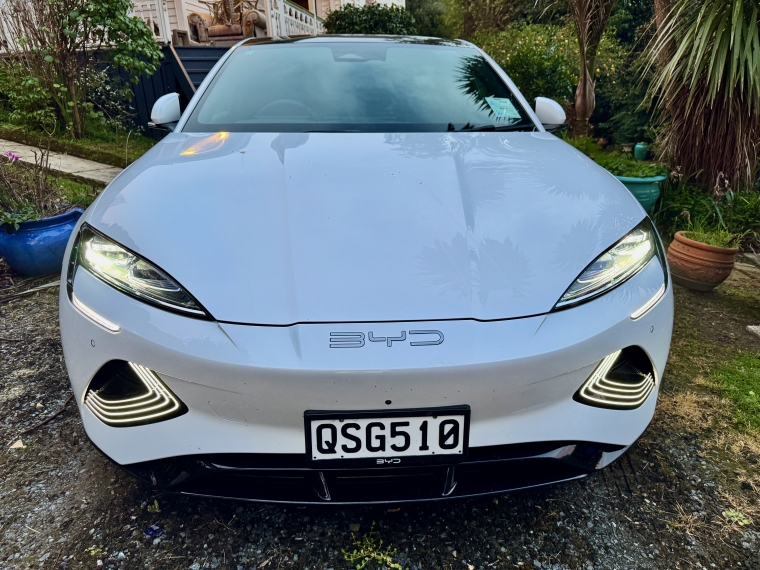
Recently at the Kaiwaka ChargeNet station, I talked to an EV owner with an Audi about batteries and car range. As one does, because EV owners are as I’ve observed, a social lot. The Audi in question was used for commuting between the Far North and Auckland, and I asked the owner if she enjoyed it.
“Not really. It’s much more involved than I’d like; you have to work out when it’s OK to use the air conditioning, not charging it more to 80%, and other things like that. With hindsight, I should’ve got a hybrid instead but I’m stuck with this for a while,” she replied.
It was a useful reminder that in general, people want cars to do one thing - transportation - with minimal fuss. An Audi EV with a maximum range of 450 kilometres fully charged, if you take it easy and don’t use the aircon, less if you do, might be too much fuss for some people.
Enter the BYD SEAL Premium: this is a full EV, on which the computer estimated there was 650 kilometres range after it learnt how I drove. The SEAL Premium wouldn’t go quite as far as the estimate suggested, but the official 570 km was attainable and it went even a bit further at times. What’s more, the heat pump aircon and bum-cooling vented seats don’t reduce the range much, so you’re good to use them instead of opening the windows and go deaf in one ear while blemming down SH1.
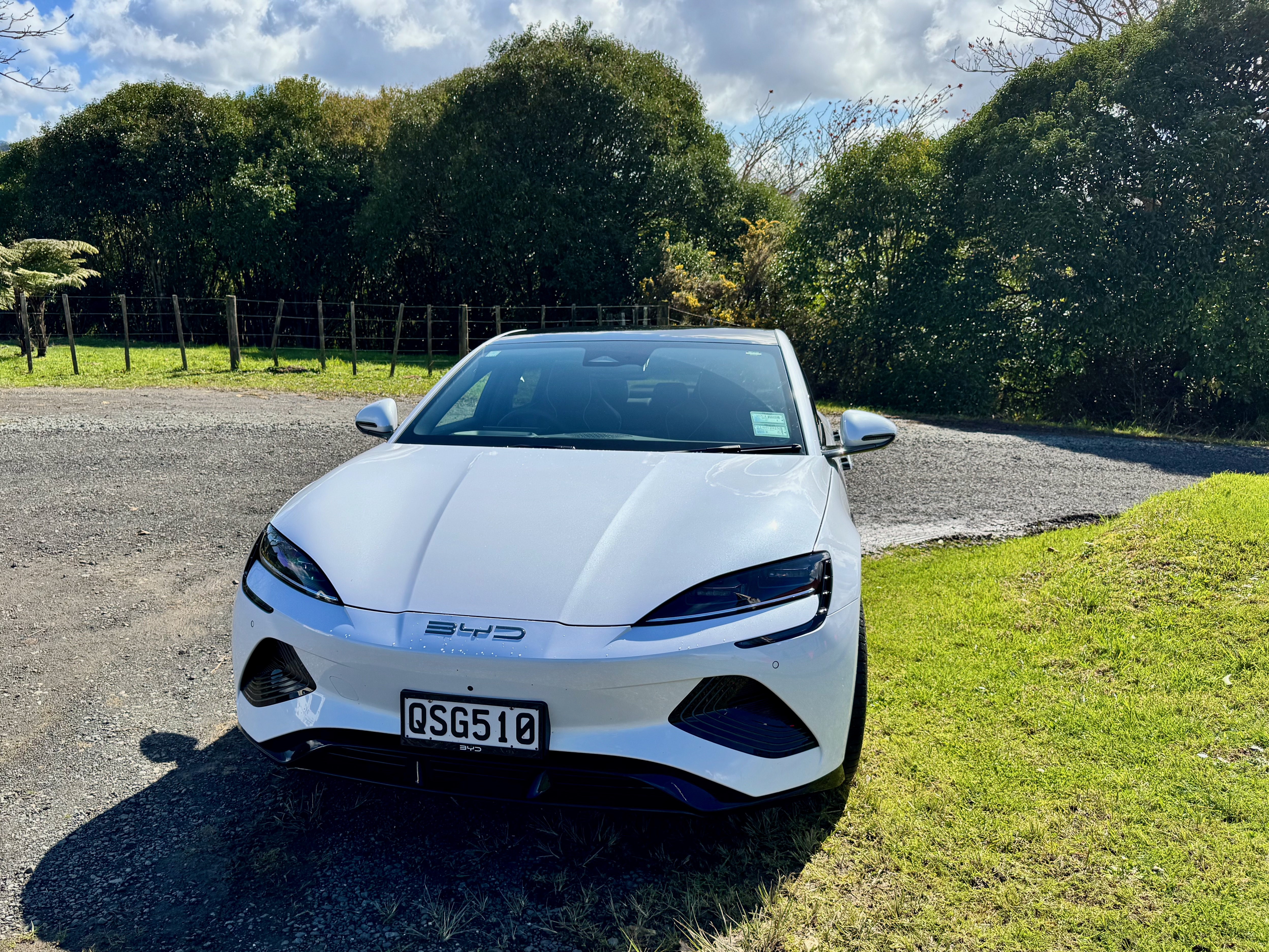
BYD has another ace up its sleeve (and yes, I know, nobody puts playing cards up their sleeves anymore) which is the lithium iron phosphate (LiFePo) chemistry blade design battery. Without getting too geeky, LiFePo has a bit less energy density than lithium-ion ones but it handles being fully charged just fine. In fact, BYD suggests you charge the chunky 83 kilowatt hour battery to 100% once a week. Tesla and BYD use LiFePo batteries. It is also a structural part of the car chassis, and doesn’t eat into cabin space as much as other battery designs.
With all that in mind, I felt for the Audi owner and thought about offering to swap vehicles with her. Doing so might have counted as carjacking of sorts though and BYD’s local distributor ATECO would not have approved of it so I thought better of it.
Premium quick and but not Performance superfast
If you’ve been looking at the BYD EVs, you’ve no doubt seen the SEAL Performance model. This is a hugely fast sedan that does the 0-100 km sprint in a supercar-like 3.8 seconds. It has 390 kilowatt of power and 670 Newton metres (Nm) of torque divided up between two engines, propelling the car with all-wheel drive.
To handle that power, the Performance comes with frequency adjusting suspension and advanced torque control (iTAC).
The Premium model sits in the middle of the SEAL range, and doesn’t have all the go-faster bits. It’s real-wheel drive, has standard suspension and “only” 230 kW of electric power with the 0-100 time quoted as 5.9 seconds. I managed 6.1 seconds in sports mode, as measured by the handy dashboard chronometer. Plenty quick.
Other than that, it’s as well-specced as the Performance. Which is to say it has everything you need in terms of driver assistance features, decent-sounding audio from Denmark’s DynAudio, memory seats, vehicle-to-load (3.3 kW max), intelligent adaptive cruise control and lane keeping and steering assistance.
That makes the $69,990 RRP Premium the sensible choice in the range: the 50 km official range improvement is very welcome, It seems worth the $8k premium over the SEAL Dynamic that goes 460 km with a smaller, 61 kWh battery.
If you crave the 3.8 second 0-100 sprint, it’ll cost you another $12k and a loss of 50 km range (officially). Hmm, 3.8 seconds though...
Warranty is a solid six years or 150,000 km. That includes eight years of roadside assistance plus the main battery being guaranteed for eight years or 160,000 km with 70 per cent state of health.
A very Euro inspired SEAL
Pivoting to electric cars after starting off as a battery manufacturer in the mid-90s has made Shenzhen’s BYD a familiar name around the world. Speaking of the name, it comes from the original Yadi Electronics that the company was called, with a B added for alphabetical advantage in listings. That’s it: bi ya di. The Bring Your Dream backronym that was festooned on earlier BYD car models has now been dropped.
Why SEAL? There's an ocean theme going on here. So not the British singer who the kids haven’t heard of, or anything tarmac related. That’s why there are SEALIONs, DOLPHINS and SHARKS in the BYD range. Why the model names have to be capitalised is another question.
Looks are subjective, but to this writer’s eye, the SEAL’s design is really rather fetching and European inspired which is not so surprising as BYD's head designer is Wolfgang Egger who drew the beautiful Alfa Romeo 8C Competizione.
The review car was white, and there's nothing wrong with that per se but the Arctic Blue paint option surely has to be the one to go for.
As you can tell from the pictures, the wheels are chonky 19-inchers with Continental tyres. They trade off good looks with increased vulnerability to flats and kerbing, and up the energy use; however, BYD’s suspension engineers have done an excellent tuning job so the ride is very quiet and comfortable even on rough tarmac. As is common with EVs, there’s only a tyre repair kit and not even a space-saver wheel in the SEAL Premium.
Step inside, and life behind the wheel is rather nice in a cabin where the materials feel very high quality and premium.
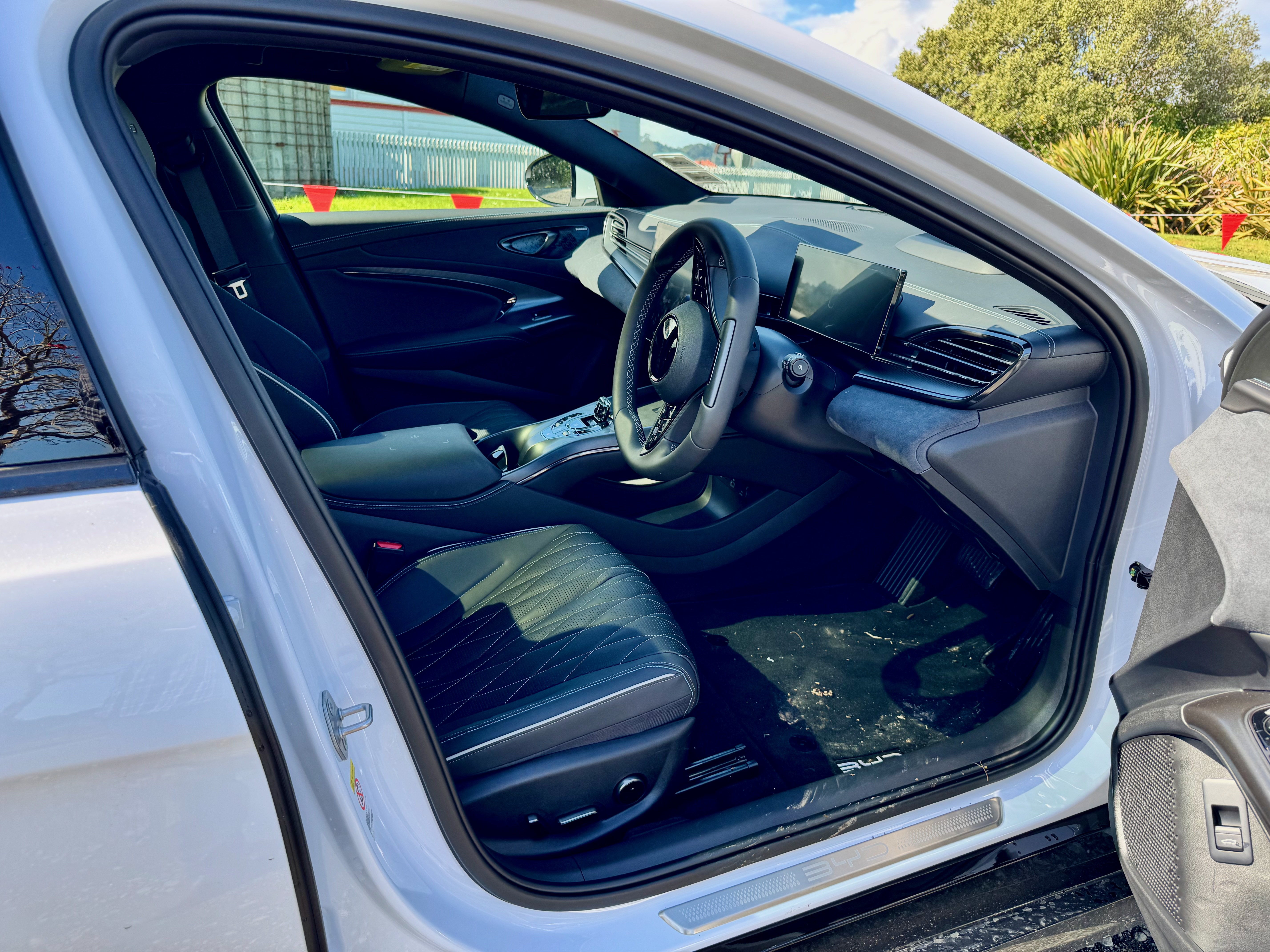
The leather upholstered front seats have power adjustment for the driver and passenger, so cost-cutting there. Rear seating is good too, with plenty of legroom. While the roof slopes aerodynamically which reduces rear headroom, yours 185 cm height truly fit into the rear seats just fine. Basketballers in the back might be tricky to accommodate in comfort though.
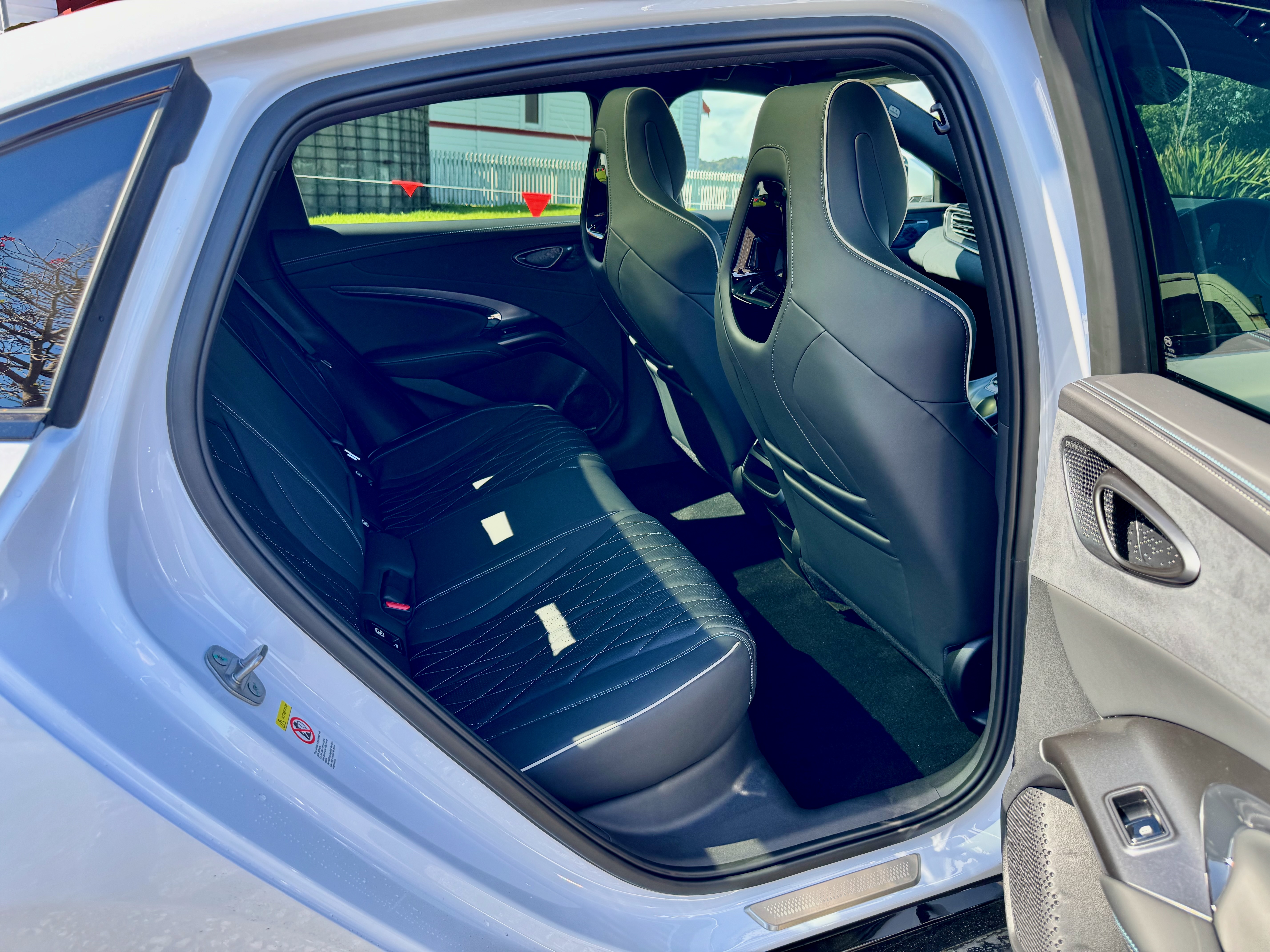
To set up the SEAL Premium to your liking and turn features on and off, you need to get the hang of the big 15.6-inch touchscreen, with the car operating system being Google’s Android Auto. The touchscreen does BYD’s trademark party trick of rotating 90 degrees. It would be useful if, say, apps in Apple Carplay (the SEAL connects iPhones wirelessly incidentally and there are two Qi charging pads) could make use of it, but they don’t.
Furthermore, slip on your glare-reducing polarising sunnies and the screen goes black in portrait mode, ditto the heads-up display.
“Oh no, I want physical buttons, and not everything on a touchscreen!” I hear you on that, and agree. Luckily, the many commonly used features can be accessed via the steering wheel buttons. Like, changing the temperature of the aircon. Also, there are stalks for the indicators and windscreen wipers, thank goodness. The stubby gear shift lever is traditional too, and it's surrounded by buttons for car functions like starting, switching the traction system on and off, and selecting the drive mode.
The drive modes make a quite a bit of difference for how the SEAL Premium behaves. Eco really means that, with car responses calmed down considerably; it doesn't add heaps to the range though, so leaving the Premium in Normal feels much nicer. Drop the Premium into Sports mode and you'll shave off 15 km or more of range, the steering stiffens and the car feels more responsive.
There are a few interesting translations in the car display, like “warm tip”, “the Windows [sic] opened”; the “comfort parking” thing I couldn’t instantly work out. It’s not self-parking which I’m a fan of, but OK, the sharp cameras with 360 degree view make it easy to do so manually. Instead, comfort parking appears to be a smooth braking feature.
BYD provides over-the-air software updates for the car, which is networked with cellular connection. None arrived during the review period.
One feature that looks great but feels suboptimal for New Zealand conditions is the panoramic glass roof. It’s insulated, but there’s no sliding cover, only a manual spring-loaded one. The glass roof makes the cabin feel more spacious and airier, but even with the insulation the heat of the sun can make it through to the inside of the car. Which is why you’ll appreciate the aircon being usable, and the vented front seats.
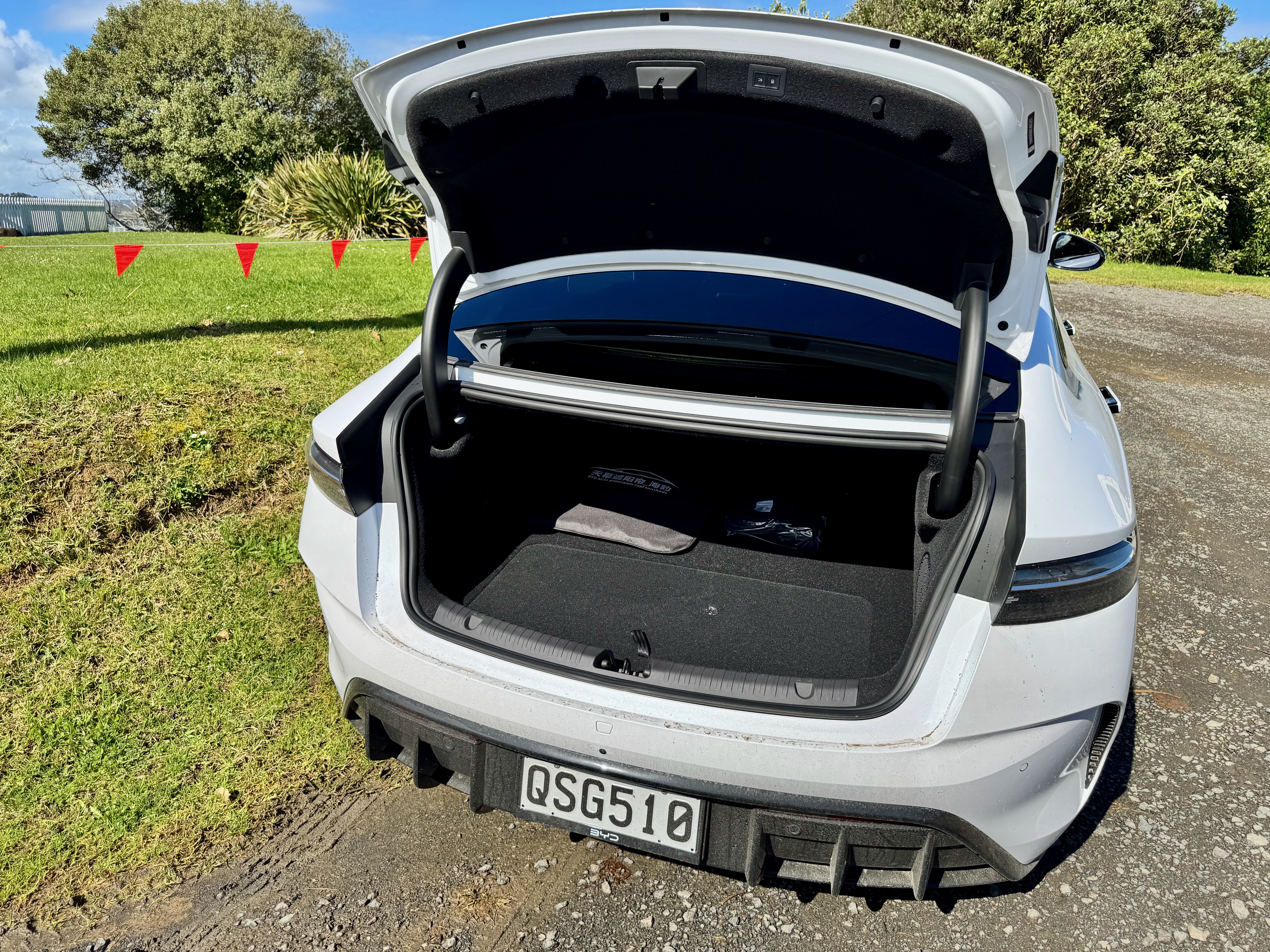
Other than that, the Premium is a sedan; while the rear seats fold down for additional luggage space, the boot isn’t hatchback-big and easy to access. It swallowed a huge ice hockey bag plus sticks, and there’s a small storage compartment under the front hood.
Driver assists still need fine tuning
Diving in town needs a little care as the SEAL is a low sedan. No doing the usual stunt driver jumps over speed humps that suburbanites engage in pursuit of economic growth, mmkay?
On the highway, the SEAL is simply lovely to drive. As I mentioned, it’s quiet despite the big wheels and you don’t think about 2000 kg weight while cornering. There’s more than enough acceleration, the brakes are fine, and the traction control means you’ll disappoint the kids who’ve learnt rear wheel drive is the thing for drifting.
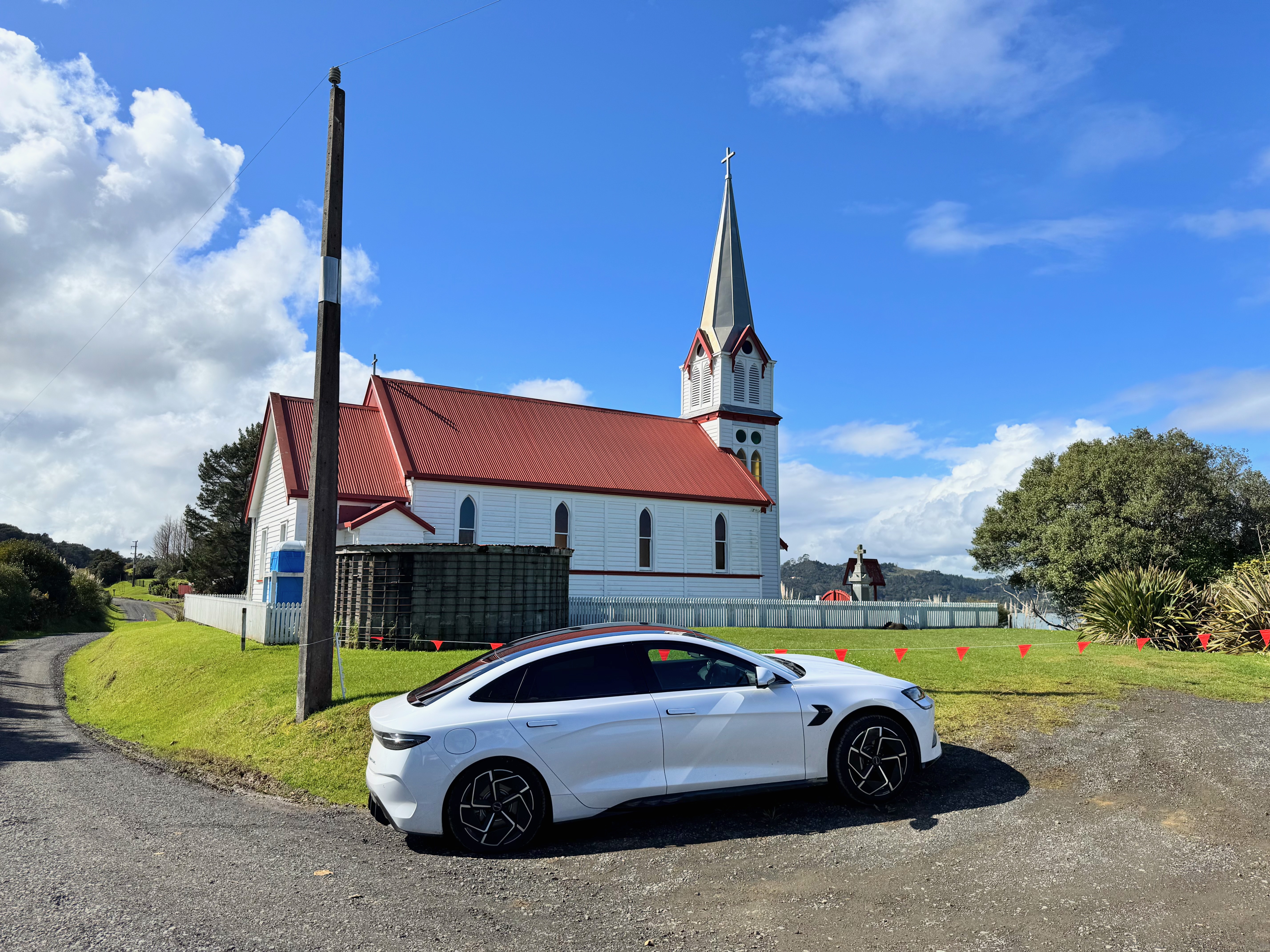
ATECO said there are 29 BYD engineers stationed in the region to keep the marque’s cars running smoothly and they’ve already provided improvements. It would be great if the engineers could at least add an off-button for the incessant bonging sound the speed limit sign detection makes, when it usually erroneously thinks you’re going too fast.
This might not be possible though, as it appears BYD uses a third-party driver assist system. In a similar fashion, the lane keeping can at times be at odds with the autonomous steering. The latter picks the correct path through a bend which upsets the former as you get too close to the white lines. It’s meant to be intelligent, but ends up being twitchy on some stretches of road.
In fact, it is reminiscent of driving a BMW some years ago, in which the self steering kept you in the lane just fine but unnervingly kept correcting itself in a manner no human driver would. Toyota’s system is smoother. You can turn it all off, and the adaptive cruise control by itself works great, but having to do that each time you set off is a pain.
The SEAL Premium is also the first car I’ve tried that can use your smartphone as a digital key, as devised by Google and Apple. Here, BYD joins an exclusive club of car makers, including BMW, Genesis, Hyundai, Kia, Lotus, Mercedes-Benz, and Rivian.
For Apple iPhones, you add a digital key to the Wallet app on the device and that’s it: no more physical car key required. You can share keys with other smartphone users, and there’s a near field communications (NFC) sensor on the driver’s side wing mirror for entry and locking the car. The digital key can also be set for proximity sensing entry into the car, and it all works well. No more physical car key required.
The longer story here is that using your smartphone as a car key is most likely more secure than manufacturers’ entry devices. Furthermore, the keys can be managed for rental and short-term hire cars for example.
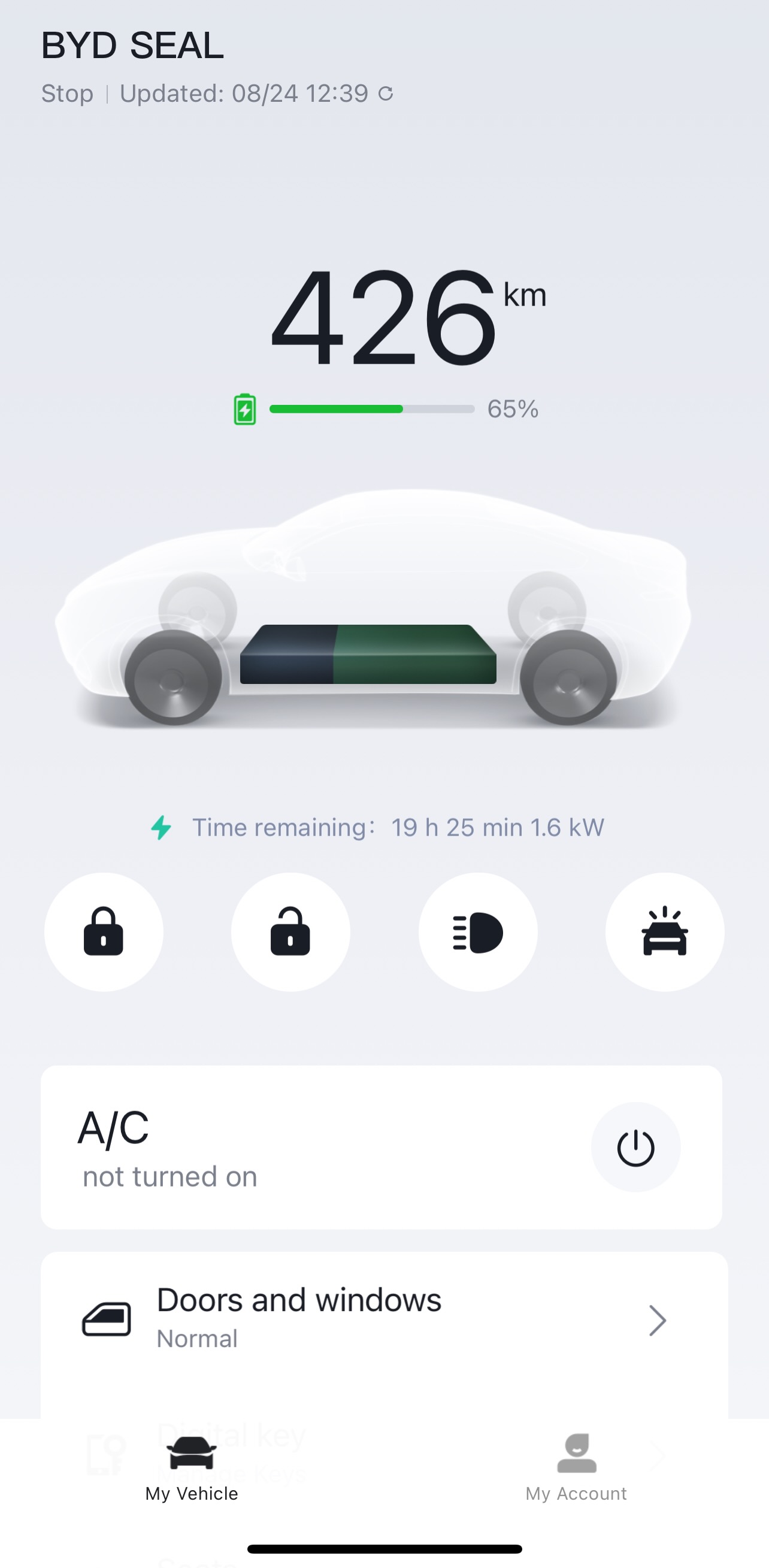
BYD’s iPhone app was quite good too, allowing remote control over some vehicle functions (no, not when moving and only the safe stuff when still). It did give overly optimistic range readings after charging sometimes, with the car reading 15-20 kms less compared to the app.
Decent charging rate
With the range the BYD SEAL Premium has, and I saw reported energy use of 13.8 to 20 kWh per 100 km, there was no need really to stop in Kaiwaka to charge. But, I wanted to see how fast the SEAL would charge, and what the tapering-off was like, once the battery hit 80%.
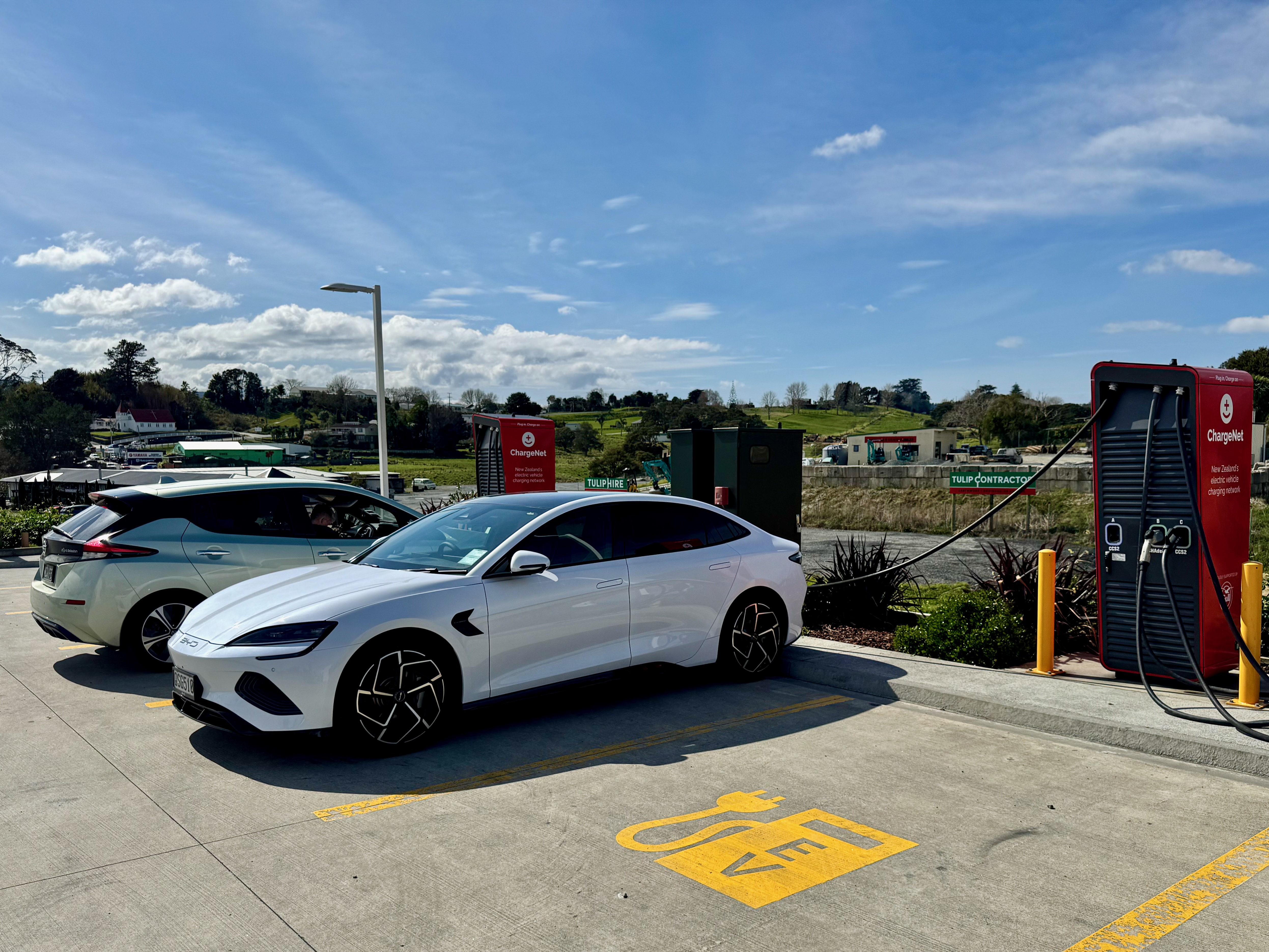
On the 300 kW ChargeNet charger, I saw just over 125 kW - the SEAL is rated at 150 kW max. Going beyond 80% gradually slowed down the charging, but even when you reached 95% the SEAL was still adding power at a rate of 45 kW. Which is really good, in my opinion. A twenty minute top up stop is ample.
AC charging maxes out at 11 kW and there’s a Type 2 adapter included. It'll take a long time to fill up the battery over a normal 230 Volt line (best I saw was 1.6 kW), but at least the option is there to add some kilometres at just about anywhere.
One pedal driving? We don’t need no steenken one-pedal driving!
There are two levels of power regeneration in the SEAL Premium. I drove at the highest setting to recoup electricity while coasting downhill (in the Premium, we’re not talking about my career). However, unlike most other EVs I’ve driven, there’s no one-pedal driving so you need to use the brakes to stop the Premium.
An ATECO rep told me that the reason for this is that one-pedal driving is very inefficient. That was a surprise, but Porsche thinks the same.
China taking a dim view of one-pedal driving after Tesla crashes, and apparently looking at banning it completely by 2026 could be another reason.
Conclusion: a very pleasant EV tourer
The BYD SEAL Premium turned out to be very easy to live with overall, striking a good balance between hi-tech and the traditional. Comfort levels are high, ditto the quality feel of the car, particularly when you consider the price of the Premium.
With the range the Premium is capable of, you’ll be depleted before the battery state of charge becomes a worry. Anything over 300 km is more than adequate for the vast majority of use cases, but an EV that goes further undeniably improves the driving experience. Add a wallbox at home, you’re looking at cheap kilometres despite the unfairly high road user charges (compared to petrol excise) on top.
102 Comments
I hear there are some great lease options on EVs in other countries right now, due to slowing sales, but not seen much in New Zealand yet.
Especially on these Chinese startup EVs. Most would not touch one. Lease or buy. They are like Japanese cars in the 70s. Basically rubbish. The Japanese eventually produced good cars, but it took a good 30 years. Will be the same with the Chinese manufacturers.
I don't think you can say that Chinese manufacturers are today where the Japanese were many decades ago. Times are too different, and globalisation has changed everything. Lots of Western marques like Tesla and Volkswagen make cars in China, which has the largest automotive industry in the world. Volvo and Polestar are now made by Geely. [Edit]: Just about all Japanese car makes have production in China as well.
Did I miss the total price?
Added, thanks for spotting that.
Oh well. I guess we are talking about a style of car with many flaws, that’s too expensive, not practical, and has terrible resale value, and collectively the brands have market share of around 2% and falling sales. Let’s see what happens.
"Not practical" yet sales numbers are pretty respectable for a sedan? It's practical for 99% of journeys that most people will make and many of us don't buy a car for and edge-use case that we can hire or borrow to get around.
I think there is a difference between Made in China (i.e. Tesla, etc) and Designed and Made in China. Having said that, they are catching up fast.
With the speed that technology moves these days, the Chinese have already moved past the competition with a brand like BYD. Still wouldn't buy one however, I'm an ICE hot hatch guy with a 6 speed manual gearbox, I love driving, changing gears and the engine noise.
I'm a boomer.
But your boomer comment is seriously embarrassing.
It reeks of a dinosaur mindset.
You’re embarrassed by someone’s own preference for cars that has 0 impact on you? Come on Chris you’re better than that.
You’re embarrassed by someone’s own preference for cars that has 0 impact on you
Might want to have a think about that last part of your comment chief.
Gen X here, grew up rebuilding motors, modifying cars and doing all my own mechanical and electrical work, my cars never see a "Workshop". Good luck with that with your EV. I'm sticking with what I know and what I can repair myself, I know how to get 20 plus years out of an ICE car.
With the average age of a car in NZ being 15 years, I'd say most people "know" how to get 20 years out of an ICE car. Often not doing much (level of maintenance in this country is abysmal). Past 30 years comes the challenge.
Our AWD Japanese wagon passed its 20th birthday at the end of last month. Yes, I'm tragic, I know its build date. Last year we used it for several months post-cyclone doing supply runs out into the backblocks of Hawkes Bay as well as areas like Pakowhai and Esk Valley. I've taken it up dusty roads that were rutted enough to shake the rear view mirror loose - I blame the people who replaced the windscreen about 8 years ago for not securing it correctly. My children learned to braille-park in it in the paddocks. It's full of hay because we use it for deliveries. Every corner is rounded and every panel is scratched. I don't know when I last changed the oil in it, I think it was 6 years ago.
It currently has a dodgy cam position sensor after the engine bay was completely caked in silt from the delivery runs. I haven't got around to replacing yet because after a small stumble at startup it recovers and runs like clockwork, every single time. If it lived in a city environment and was owned by someone who cared for it, I suspect it'd easily make 40 years plus. Modern cars just keep running.
If it's a Subaru you really need to change the engine oil a lot. Mine was made late 2004 so its coming up 20 years old in a few months, great car in a wagon with 6MT.
Yeah so did I but man is it nice to get into a Chinese electric car (MG) that just works every morning and requires almost zero maintenance!
Meanwhile my collection of ICE bikes can then be restored/modified without the time stress....
Also Gen X sick to death of having to maintain and fix ICE cars, been driving BEV's for over 6 years, I spend my weekends on the road not under the car.
Well it helps if you buy a new car, pretty much nothing to do on it for the first 5 years. Only recently purchased my first ever new car, its a age thing eventually you get sick of major work on it. Things like filters and oil and brake pads are easy plus if you get it new and change the oil frequently the engine will go for 30 years. Probably my new car will outlast me now and probably the whole human race the way its going.
What cars were you buying that required so much major work? The only car I've ever had to do what I would call moderate work on (i.e. excluding wear and tear items like brake pads/discs and suspension struts) was an old Holden Commodore that needed things like intake manifold gaskets replaced along with various under-bonnet hoses and power steering pump. Every other car I've owned has been generally reliable no matter the age or country of origin. Maybe I'm lucky.
Personally I love ICE vehicles. Unless I'm physically forced to own a lekkie I will never do it. When I'm in NZ my daily is a 60s chev, it has character, always leaves me guessing whether it will make it or not... it's an adventure everytime I turn the key. And it doesn't beep and bong at me.
Gen X
ICE cars are much more exciting - you never know what's going to break next
RWD>FWD and I will die on that hill.
I was like that 2 years ago but technology has moved on now. The combination of the E-Diff that provides torque vectoring, 19 inch wheels now and much improved tire tech has seen most of the disadvantages of FWD disappear. FWD is also cheaper to manufacture and lighter with less power train losses. I have done the full circle and now back to driving a FWD car.
Physics hasn't moved on though. A RWD platform inherently offers better balance due to their longitudinal drivetrains, which enhances acceleration through weight transfer and more effectively puts the power down. FWD drive cars are fine but they are in no way better than RWD cars apart from being cheaper. Subjectively you might enjoy them more but objectively they are worse in nearly every way when it comes to performance.
In fact many electric vehicles are designed with RWD drivetrains and receive high praise from reviewers compared to FWD EVs, as the RWD setup is simply superior for performance.
I'll concede your point the day Porsche releases a FWD car or Formula 1 switches to FWD. But until then, I'll stand on my hill that from a performance perspective, RWD is objectively superior to FWD.
Nothing is funnier to me than people who die on the RWD hill and tend to forget game-changers like the Mini, Audi Quattros and the peak of racing; modern WEC cars are all definitely not RWD.
F1 cars are required to be RWD. The most recent 2WD car to win a WRC event was FWD, not rear-wheel drive. And no, they are not ''objectively' worse than RWD; see the stacks of touring car titles won by front wheel drive cars in the 1990s up against RWD opposition. Arguably that is far more relevant to road-going cars than one-off single seater racing series.
It's a different dynamic of car, for sure. Perhaps less rewarding, depending on how you prefer to drive. I suspect most people who enjoy driving probably don't care and will drive anything, given the chance and don't really consider it worthy of becoming a personal branding exercise like some do.
I might be coming across too harsh on FWD. It's more about Zwifters stating that the technology has moved on, which isn't the case at all. It's not like RWD vehicles have stagnated and been leapfrogged by FWD vehicles.
FWD cars can be great, but in most cases, they are outperformed by either RWD or AWD cars. Ultimately, it mostly comes down to personal preference, but I don't think there's a credible argument to be made that FWD cars are better than either RWD or AWD from a performance perspective.
Sadly an i30N is now quicker round the Nurburgring than the E46. Technology moves on all the time, even with ICE cars. I would have stuck with Subaru but they lost the plot.
I would say the tyres have moved on more than anything else. And an i30N has an 8 minute lap time whilst the top spec E46 has a sub 7 minute lap time.
E46 still got that dawg in it. No i30n will ever sound this good.
Besides, ya always look really silly doing skids in a FWD.
Now that's something I can't argue against, but that's why God gave us Maccas food trays and darkened car parks.
E46,
You clearly know a lot more about cars than I do, but I can tell you that my FWD Audi A4 performed a great deal better in snowy and icy conditions in Scotland than my business partner's RWD BMW.
I wouldn't say I know much lol. I should probably add a caveat that RWD is better in ideal conditions. When traction is more limited, FWD cars can have an advantage. However, AWD will outperform both by a significant margin. Snow tires can help mitigate this, but all things being equal, FWD will have slightly better traction in snow and ice since the weight is over the drive wheels.
For the same reason, Porsche 911's actually perform very well in snow since the engine weight is over the drive wheels, similar to the Lancia 037, which was the last 2WD car to win the WRC.
It also helps massively to be able to point the driven wheels in the correct direction in snow and ice. Thatsca major reason for fwd fun in the snow.
Seventies Japanese cars weren't rubbish. The Honda Civic which came out in 1972 was far superior to the Mini. The Datsun 240Z was awesome. Japanese motorcycles soon dominated the market in the 1970s too.
Here's a non-rubbish 240Z beauty, from 1973. Was just thinking that there's no way 70s Japanese cars (or motorcycles) were rubbish. Otherwise they'd never have become as popular as they are. Let's compare them with British and American cars from the era then.
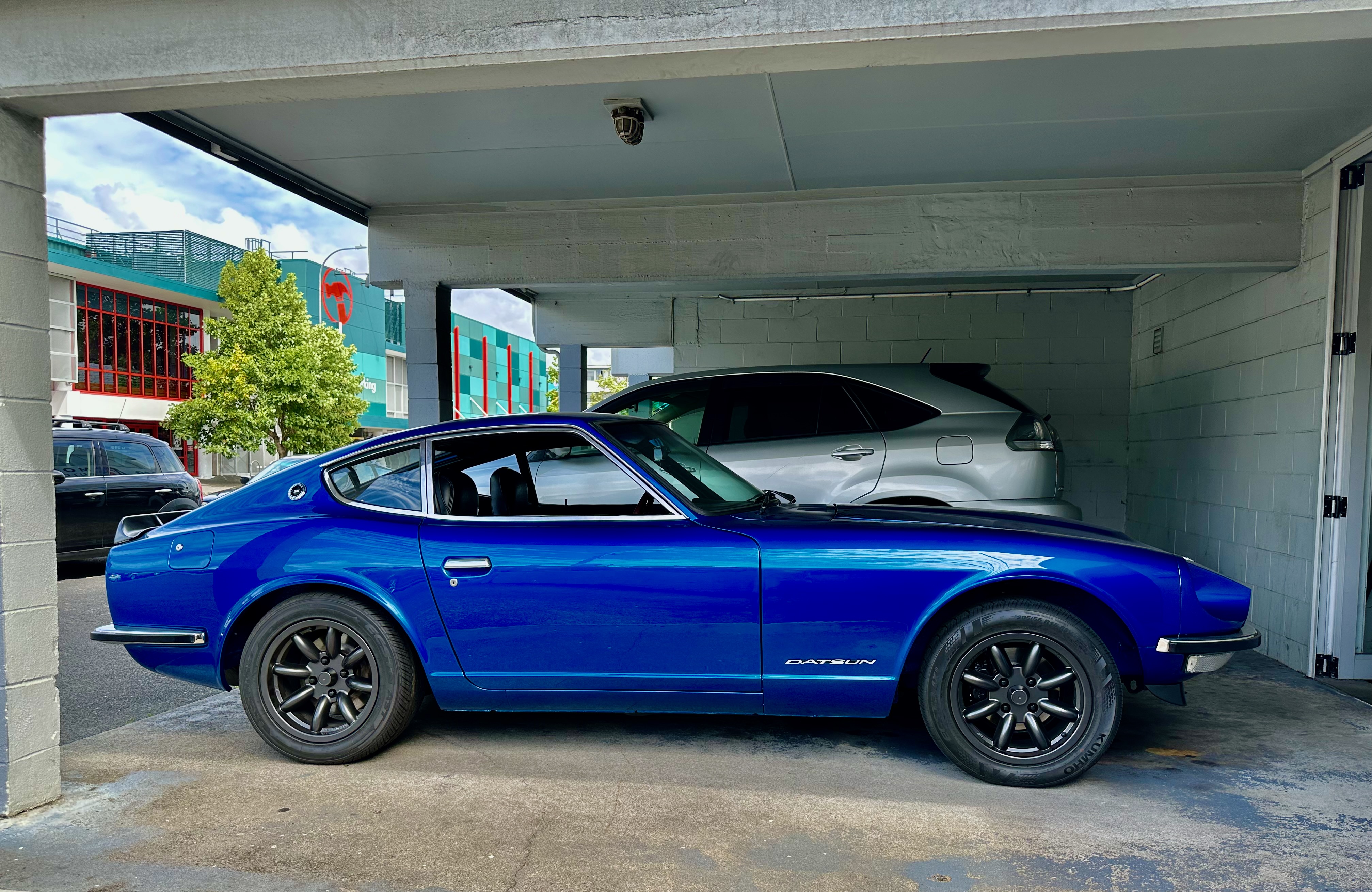
I agree there were some good ones. That one obviously and the early Mazda rotaries (even though they did have oil leak issues).
The shapes they used were to die for but the size was very small relative to today. I’d take a mid-late 70’s corolla SR coupe anyday, they are so slick.
Indeed, and the first generation Toyota Celica was even slicker. The Datsun 1200 ute was cool too, and the Mitsubishi Galant GTO. The seventies was when Japanese cars and motor bikes really began to shine. Averagejoe's "rubbish" cars was more likely referencing the first Japanese car exports after the war.
Eventually that Gen 1 Celica sprouted into the Sixth-Gen and that would still be a fresh looking design if Toyota dropped it again today. It took roughly a decade and a half to go from the RWD gen 1 to the kerb-stomping Group A inspired GT4s. How far away is that moment for upstart EV brands?
The 70s is when Japan really got their act together but they still weren’t on top of rust control. I suspect that’s where China is now.
Amen: too many oily weekends under contemporary Morrises, Austins, Hillmans...
averagejoe: "Especially on these Chinese startup EVs. Most would not touch one."
So you never buy anything from China? Your house will be awash with "Made in China" stuff. All of which - if you didn't 'trust it' - would burn your house to the ground!
Methinks you're full of it.
Except it’s not. I made sure that almost everything my house is built with was not made in China. Particularly not any building materials or structural elements. My architect recommended I take that approach, even though it cost more. Structural problems are not easily fixed once stuff starts falling apart or becomes a fire risk. I did select some well known western brands that do manufacture in China for some small Non structural items, but only the quality ones, and no nonameo stuff. At the time, there was scandal in the Uk I believe, with the outside of buildings catching fire (Chinese fireproof cladding) same materials used in apartment builds etc in Australia. So best to stay well away from that stuff.
I suspect the reference was more towards your electronic goods and whiteware. even if the product was assembled in (for example) Germany it is likely still full of Chinese-made components.
Chinese fireproof cladding, you say? The majority of the cladding was from an American company, Arconic, headquartered in Pittsburgh, sold through a French intermediary. Other mis-sold, inappropriately flammable, products were from an English company (Celotex) and an Irish company (Kingspan). All well-known western brands. https://www.housingtoday.co.uk/news/manufacturers-knowingly-misled-the-….
Being of an age that remembers Japanese cars showing up in the market in the 1970s and, if being a bit rust prone (but still better than Italian: remember the Alfa Sud where you could hear them disintegrate?), they were vastly better engineered and built than the English competition, and were vastly cheaper than anything European, other than genuinely dreadful things from firms like Soviet-era Skoda. American cars of the time were pretty poor as well, but they had the merit of being relatively simple and over-engineered enough so they could be fettled to be reliable.
When do you now see something like a Maxi, Princess, Allegro, or Avenger? There are still a bunch of 1970's Corollas, RX-7s, GT-Rs, assorted small utes and the like in the hands of kids doing the JDM modifier thing, as well as collectors who hunt the original-one-owner examples.
I suspect you never grew up having to deal with the joys of British car ownership that includes: endless oil leaks, Lucas (prince of darkness) electrical systems, elderly design mechanicals that kept being put in to new models, the need to do things like a valve grind every 20,000 miles, cracking blocks, haemorrhaging cooling systems, heating systems that needed an asthma inhaler, demisters that didn't, windscreen wipers that went on strike in the rain, indifferent-at-best dealer service, relentless gouging for import-controlled parts, miserly 12 month warranties, and all the rest.
Japanese cars typically didn't behave like that, and their systems worked for the - quite long - life of the car.
The management of the English motor industry is what made it great today, with any volume nameplate owned by someone overseas who installed their own management, leaving only some interesting niche and bespoke makers run by people who were actually good engineers and not amateur managers.
As someone who spent many weekends with oily hands, things were absolutely not better in cars other than Japan's.
Illustrative story: a friend's father had a new Daimler 5.3 litre V12 from new (in those days farmer=money). He was careful with it, but six months outside the 1 year warranty the block cracked. NZMC didn't want anything to do with him, and with no disputes tribunal in those days the court costs of going after them were prohibitive. The repair price was beyond belief, so for far less an expert mounted a hand-built Chev V8 that neatly mated up to the existing GM TH-350 the Daimler came with: better fuel economy, more power and better reliability.
The extremes we had to go to get reliable cars is why the Japanese car firms were greeted with open arms. To quote a mate who was a bike guy: "oh my god, it's built like a watch!!" on opening up a Honda 360 twin...
You know BYD make Tesla's batteries, right?
Tesla Berlin uses BYD batteries in some model Ys, but NZ doesn't get any BYD batteries in Teslas, we still get CATL sourced LFP batteries out of Shanghai afaik.
Today's electric cars are 1980s laptops.
You can't beat a depreciation curve with fuel savings in a laptop. Soon my Leaf will save me more a year in fuel costs than its value drops by. That's a hell of a thing for a used Japanese family hatch.
Who knows, someone might one day finally get a viable LFP pack for them as a third-party option. Until then, it's modern, safe and has Apple Carplay / Android Auto and 360 cameras. I only lose if I sell it for something else at this point.
I think of them more of a Toaster, you just don't want to be in it when the lever decides to go down.
No.
More like 2020s laptops.
I think it looks good. A concern I would have with constant model updates, is 5 - 6 years down the track will you be able to still get parts for them? Might be wrong but suspect more a case with Chinese vehicles. And yes I know - they have fewer parts than ICE vehicles….
Leasing might be a good option but yeah depreciation would be an issue - guess that assumption is built in to the numbers up front.
What parts are you talking about...?
Lights, front bumper after minor smash, door handles, aircon bits, bits of suspension - struts etc……
So all the things that have nothing to do with its motive power?
So .... Much the same as every other car then?
Probably not an issue with BYD, but there is a massive oversupply of EVs out of China, and not all the companies will make it through the next 5-10years. Look at what happened with Fisker
Good question. There's a fairly long warranty, many bits are shared between brands (I believe Bosch is involved in the motor side of things), so I don't think it should be a concern. Car parts and finding them for reasonable prices are worth a story on its own. I maintained a 1989 Mercedes 300 CE a few years ago, and the parts situation was interesting to say the least. Tried to find a panels for a 2004 Hyundai Matrix for a friend recently, and it was hopeless, even in the scrap yards.
In 5 or 6 years it will be totally obsolete. No idea how we are going to start to get rid of these when they all start to crap out. Still the person who buys the car new probably doesn't have to worry about that.
Yep. That’s right. Todays environmental problem is being solved by creating tomorrows toxic junkyard.
"In 5 or 6 years it will be totally obsolete."
Based on your view - then that means every car produced in the last 50 years, right?
Sounds quite a bit like my turbo Mini. Not a hybrid inverter or DC motor in sight. They absolutely lunch themselves as soon as they're out of warranty period - if you were lucky, it happened before that.
In five or six years my Leaf will still be giving me 180km of charge and saving me close to $3K a year in petrol.
No, it will be like the 15yo computer in the corner, looking a bit dated, and no new fan dangled bits like USB3, but still chugging on. Keep throwing tyres, wipers, and electrons at it and it'll keep going.
Pragmatist,
Our 2017 Leaf is just fine thanks. We have had it for over 3 years as our second car and we do most of our local driving in it. The battery charge has only dropped about 10% over that period and the servicing costs are minimal. We have no regrets about its purchase. My 6 year old Honda HRV has only 55,000 on the clock an d I expect both to see me past my motoring days.
Its taken a while for me to figure it out ...but when you see an ev in front of you going slow...its likely because they are low on batt power and trying to get home....lol
Is that the same as slow ICE cars in front of you as well?
“Its taken a while for me to figure it out ...but when you see an ev in front of you going slow...its likely because they are low on batt power and trying to get home....lol”
lol so true with every Tesla/EV on the road.
Can always remember this one time we took a trip down Deep South and saw this driver crawling along at 30km/h in his state of the art Tesla because the battery’s on life support. The look of sheer panic on his face as he desperately scan the horizon for a charging station that’s never coming? Priceless.
But hey, at least they’re saving the environment—one painfully slow kilometer at a time!
I'll take "things that never happened" for $500 Alex.
Man, pathetic opinion. Do you also stop and laugh at people broken down at the side of the road?
Hope you never experience any misfortune, sounds like karma doesn't owe you any luck!
Still quite a few 1990s / early 2000's prius running around.
Once we get a network of ev repair centre's going , no reason why an electric car can't do 30 years, with a battery rebuild or replacement.
Hopefully there are standards developed which force Car manufactures to make repairing and replacing batteries easy
Chinese are leading the way here ... again. The 'blade' technologies you hear about in newer car batteries are a response to China's regulation that car batteries must be more easily recyclable. And they are. A massive step forward. But, like always, much more to do. And China will almost certainly lead again.
We've had hybrids in the market now for over 20 years and our repair network is still desultory, and the charging network is still far below what it needs to be. Maybe the market is cautiously reading the signals?
Personally, I'm interested to see if this makes it's way down to personal transport. It might.
Sure, just gotta cruise at grandma speed to milk that precious range, while hugging the left lane at every passing lane, lol. And let’s not forget those hot summer long trips, aircon blasting, music cranking, because who doesn’t love watching the battery percentage plummet like a stone? Oh, and better watch out for those potholes, you wouldn’t want to upset the battery stretched across the entire chassis, or the car’s a write off. And when the battery finally limps to half capacity, it’s ‘new battery time!’ Such a steal!
At least with a busted fridge, you can recycle the damn thing. These iPads on wheels? They’ll be so outdated in 2-3 years, it’ll be tragically hilarious…
And let’s not forget those hot summer long trips, aircon blasting, music cranking, because who doesn’t love watching the battery percentage plummet like a stone?
So... like a petrol car? Where do you think the power to run those things come from on a regular car? See what happens to your fuel mileage if you do those things.
Oh, and better watch out for those potholes, you wouldn’t want to upset the battery stretched across the entire chassis, or the car’s a write off.
I think you'll find EVs have suspension and dampers, just like any other car. If a pot-hole is a risk to an EV floor then it's a risk to any car floor. They're not 1980s F1 cars with side-skirts dragging along the ground.
And when the battery finally limps to half capacity, it’s ‘new battery time!’ Such a steal!
It will take approx. 20 years for my battery chemistry to decay to half capacity. During that time it will save me close to 2x what I paid for it, and cover the kind of miles that would see many ICE cars need engine or gearbox replacements. All this does is tell me you don't understand the basics of how EV battery pack chemistries work. Decay isn't linear in a modern EV.
At least with a busted fridge, you can recycle the damn thing. These iPads on wheels? They’ll be so outdated in 2-3 years, it’ll be tragically hilarious…
Do you buy a new fridge when the old one becomes 'out-dated'? Or do you keep it as long a it works? Most people I know don't change a fridge every three years. This applies to literally any car. It still works, it still gets you from A to B.
Why do people loose their minds over EVs? Why do they think they can just make things up and invent hurdles for EVs that regular cars don't stack-up against?
I'm prepared to wager I'm as much a petrol-head as anyone else but what goes into the tank isn't part of my indentity. Less money on petrol = more money for the other toys in my garage.
EVs have already been on the market for much longer than the 2-3 years you quote and are still around. Unlike ICEs, the tech is constantly improving.
3-5 years ago they were mainly only of use for city folk. Nowadays i can easily get from Auckland to Taupo on a full charge in real world conditions, which is enough for 95% of cases.
Their performance at a given price point also leaves ICE vehicles in the dust.
Sure, just gotta cruise at grandma speed to milk that precious range, while hugging the left lane at every passing lane, lol.
You mean blasting past slow ICEs at every padding lane, no need to plan ahead and chop down a couple of gears.. just look, flex right foot and watch those cars behind disappear.
And let’s not forget those hot summer long trips, aircon blasting, music cranking, because who doesn’t love watching the battery percentage plummet like a stone?
Nope, this is nonsense, heat pumps for air con on variable speed drives, efficient as hell. The only time the AC works hard is when it's trying to cool or heat the battery for supercharging. And the only time I've noticed the battery percentage plummeting was when I was driving it like I stole it. But then again, the ICE did the same the trip meter in that got as low as 4km/L before the brakes said game over.
Like anything brand new nice and dandy, do the test drive when 1 yr 2yr and 5yrs are up that's the issue. Most people ain't replacing a new car every 1yr (great for the environment then yeah right) or 2 yrs more like 5 or longer. Then see how long the battery lasts how many ks you get out of it etc
Looking like mine will still have 90%+ in 10yrs. Still charges to 417kms.
I think the Nissan Leaf has a lot to answer for in damaging how people think about EV battery degradation.
I mean we don't judge modern smartphones by the original iPhone either, despite it probably feeling wildly unusable to modern users.
The Leaf was still not using battery thermal management when all other manufacturers had moved on though
It still isn't now! The new SUV version of the Leaf apparently will though, so it shall live on.
As BYD states, the battery warranty is eight years or 160,000 km, with 70 per cent SoH. This piece on Counties Energy reusing old Nissan Leaf batteries from 2010 that have around 70 per cent capacity left might be of interest to read.
That seems to be the default warranty on EV batteries, I can't think of any that are less.
70%? That already sounds pretty bad, assuming rate of battery deterioration will speed up even more from there?
Imagine trying to sell that secondhand. I wouldn’t go near it.
I take it you didn't read the story I linked to.
No, the decay is faster when the car is newer. It slows down with the passage of time. We're still learning a lot about shuttling and plating on NCM, but LFP decay is even slower than NCM and the densities are almost the same. It's possible in future BMS and charging systems may be able to reverse the decay we see in batteries through ordinary use in situ - there's a lot of focus on this at the moment.
It's refreshing to see an article with a lot of passionate comments that isn't related to property. Maybe interest.co.nz needs a motoring section!
That lady’s mistake was to buy an Audi etron - despite being massively hyped, just like the Jaguar iPace, it was always a terrible EV. Overweight, poor range, slow fast charging and full of bling. The Seal is a real prospect from a country & manufacturer that now leads in this space. VW, Toyota and others can’t compete and are shutting factories.
Yes, their efficiency is appalling, and slow charging just compounds it.
Yep, people look at the cost and performance of EVs from legacy manufacturers, and rightly conclude they're poor value.
At 60-70k specialist manufacturers Tesla and BYD smash ICEs up to 150k.
Its not about smashing its about the driver experience. EV's are heavy and sure they are fast from 0-60 but that's about it. All that acceleration in an EV is great but they eat tires. I don't buy a car based on the 0-60 time.
Very true, they can make an EV Toyota Yaris capable 0-100 in 2.5 seconds if they want to.
Yes, but you are in that small group of people for whom cars and driving are a hobby/special interest. Nothing wrong with that, i'm just giving you the perspective of someone who's not a car guy.
I don't think the original E-Tron was an EV specific platform. The iPace was a promising car, just beset by software issues and the struggle for ongoing investment to keep refining it.
Still easily the best looking EV you can buy though.
Worth noting BYD started as a battery manufacterer , holds 13000 patents , and autos are still only 50 % of its business.
Sorry , that should be, has applied for 13000 patents. They have 100000 research staff. I don't think they are copying anyone.
BYD will cut everyone's lunch in the EV market. If they're allowed to by captured politicians.
be keen on one of their Seagulls for a city run around
Inability to turn off lane assist and beeping is a deal breaker, I nearly got killed by this in my Mazda 6 till I figured out how to disable it; it tried to forcefully change lanes on a corner up north,nearly wrestling us on to the wrong side of the road.
I also object to giving , effectively, the Peoples Liberation Army and Navy a large subsidy by buying a big ticket item.

We welcome your comments below. If you are not already registered, please register to comment
Remember we welcome robust, respectful and insightful debate. We don't welcome abusive or defamatory comments and will de-register those repeatedly making such comments. Our current comment policy is here.